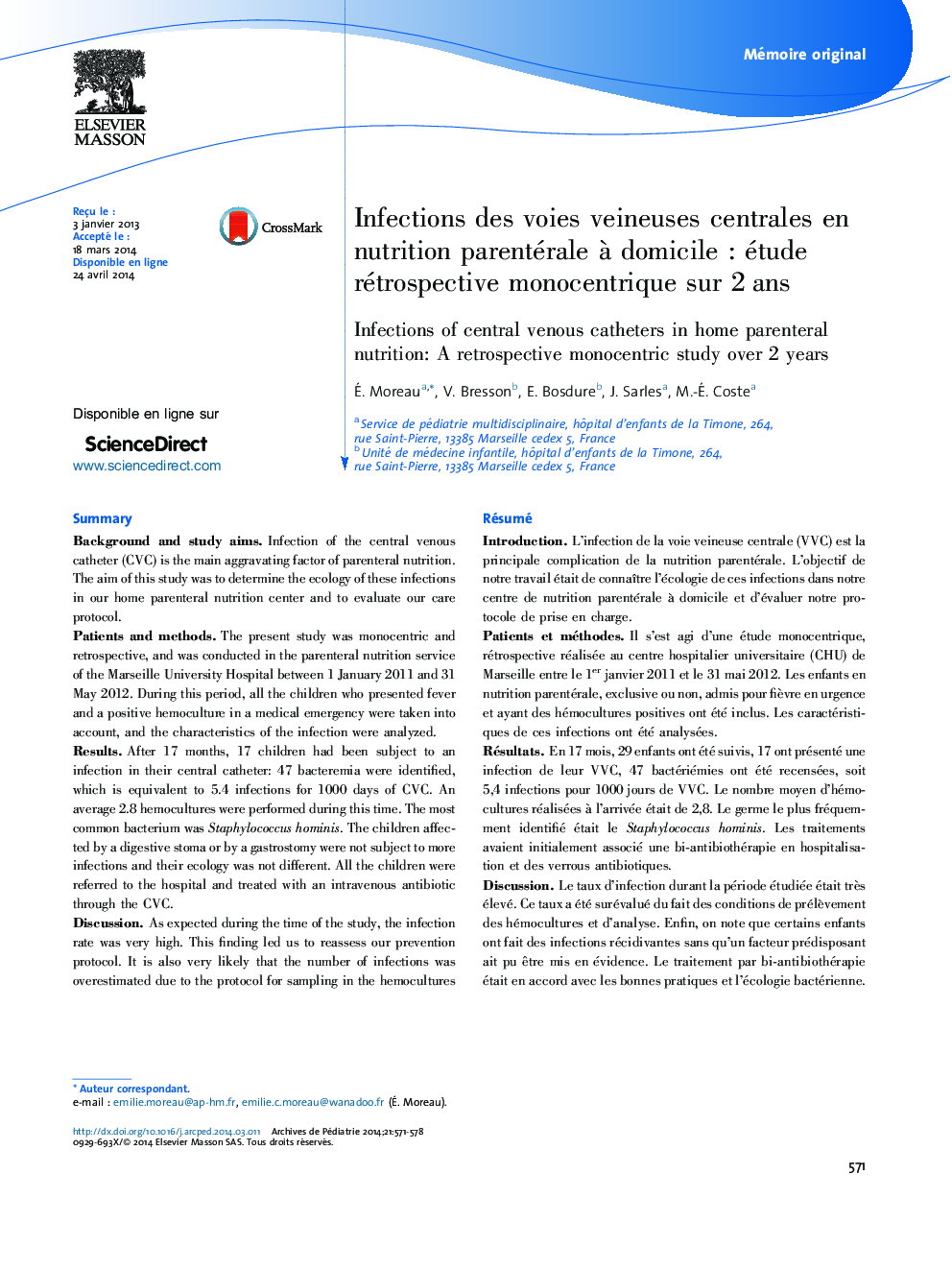| Article ID | Journal | Published Year | Pages | File Type |
|---|---|---|---|---|
| 4145958 | Archives de Pédiatrie | 2014 | 8 Pages |
RésuméIntroductionL’infection de la voie veineuse centrale (VVC) est la principale complication de la nutrition parentérale. L’objectif de notre travail était de connaître l’écologie de ces infections dans notre centre de nutrition parentérale à domicile et d’évaluer notre protocole de prise en charge.Patients et méthodesIl s’est agi d’une étude monocentrique, rétrospective réalisée au centre hospitalier universitaire (CHU) de Marseille entre le 1er janvier 2011 et le 31 mai 2012. Les enfants en nutrition parentérale, exclusive ou non, admis pour fièvre en urgence et ayant des hémocultures positives ont été inclus. Les caractéristiques de ces infections ont été analysées.RésultatsEn 17 mois, 29 enfants ont été suivis, 17 ont présenté une infection de leur VVC, 47 bactériémies ont été recensées, soit 5,4 infections pour 1000 jours de VVC. Le nombre moyen d’hémocultures réalisées à l’arrivée était de 2,8. Le germe le plus fréquemment identifié était le Staphylococcus hominis. Les traitements avaient initialement associé une bi-antibiothérapie en hospitalisation et des verrous antibiotiques.DiscussionLe taux d’infection durant la période étudiée était très élevé. Ce taux a été surévalué du fait des conditions de prélèvement des hémocultures et d’analyse. Enfin, on note que certains enfants ont fait des infections récidivantes sans qu’un facteur prédisposant ait pu être mis en évidence. Le traitement par bi-antibiothérapie était en accord avec les bonnes pratiques et l’écologie bactérienne.ConclusionLe nombre important d’infections constatées pendant la période étudiée nous a amenés à une évaluation prospective de nos pratiques.
SummaryBackground and study aimsInfection of the central venous catheter (CVC) is the main aggravating factor of parenteral nutrition. The aim of this study was to determine the ecology of these infections in our home parenteral nutrition center and to evaluate our care protocol.Patients and methodsThe present study was monocentric and retrospective, and was conducted in the parenteral nutrition service of the Marseille University Hospital between 1 January 2011 and 31 May 2012. During this period, all the children who presented fever and a positive hemoculture in a medical emergency were taken into account, and the characteristics of the infection were analyzed.ResultsAfter 17 months, 17 children had been subject to an infection in their central catheter: 47 bacteremia were identified, which is equivalent to 5.4 infections for 1000 days of CVC. An average 2.8 hemocultures were performed during this time. The most common bacterium was Staphylococcus hominis. The children affected by a digestive stoma or by a gastrostomy were not subject to more infections and their ecology was not different. All the children were referred to the hospital and treated with an intravenous antibiotic through the CVC.DiscussionAs expected during the time of the study, the infection rate was very high. This finding led us to reassess our prevention protocol. It is also very likely that the number of infections was overestimated due to the protocol for sampling in the hemocultures and their subsequent analysis. Lastly, some children relapsed easily, although no predisposing factor was found in the present study. The therapy chosen was in agreement with the best practices and the ecology recovered.ConclusionThe high number of infections observed during the study encourages a prospective evaluation of current practices.
